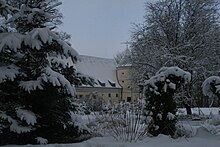Oberndorf Castle
Oberndorf Castle (called Fugger Castle ) is a two-story two-wing complex with two three-story round towers. It is located in the municipality of Oberndorf am Lech in the Donau-Ries district .
history
In 1533 Raymund Fugger von der Lilie acquired the castle and estate Oberndorf with the associated villages Eggelstetten and Flein, which the Würzburg bishop had lent to the castle . His brother Anton Fugger von der Lilie had an imposing four-winged moated castle built between 1535 and 1546. The building (see view from 1561) consisted of two parallel wings that were connected by one or two other wings and thus formed a courtyard. The gables with the dainty tower with a hood rising in between are reminiscent of the imperial city architecture of the old Augsburg town hall. The complex of the country palace as a whole shows in its symmetry and with its courtyards a certain generosity, which is entirely in keeping with the imperial dignity of the Fugger family . In 1601 it became the residential palace of Anton Fugger the Elder. J. Named founded the Fugger-Oberndorf line (which died out in 1669). During the Thirty Years' War in 1632 the castle, in which the Swedes took quarters, burned down as much as possible. Only part of the farm building was preserved. Around 1819, Sebastian Eligius Fugger-Glött, who died in Oberndorf Castle in 1826, had the remains of the building expanded into today's two-wing complex.
The castle lady, Countess Marie von Fugger-Glött, was a highly respected beekeeper. It entertained 25 bee colonies and in 1886 took part in the bee industry exhibition in Augsburg .
On the top floor of the eastern round tower is a small castle chapel with an altar decorated with gold leaf and the Fugger coat of arms . The former Fugger Castle, which was shaped by the Renaissance style, was completely renovated in the mid-1980s and 1990s.
The Tillyweg leads north of the castle park . From this side you can still throw a few "furtive" glimpses of the castle and its park, which is hidden behind trees and bushes, especially since newly planted trees of life around the park boundary (will) increasingly seal off the historical complex from the outside world.
Two imposing horse chestnut avenues (unfortunately infested by the horse chestnut leaf miner) lead to the castle. The so-called “Kirchenallee” going south to the castle is designated as a natural monument. The end of the avenue (approx. 10 trees) is in the enclosed 22,000 m² English-style park. The area is privately owned and not open to the public. However, rooms of the castle can be used for events of various kinds, e.g. B. Weddings, can be booked. The new lord of the castle opens the castle portal to targeted groups of visitors, such as primary school children from Oberndorf.
literature
- Martin Kluger : The Fugger. The German Medici in and around Augsburg . Augsburg 2009, p. 161.
- Doris Pfister: Donauwörth. The former district, Munich 2008
Web links
Individual evidence
- ↑ Pfister 2008, p. 155
- ↑ http://www.imker-schwaben.de/1776093.html
- ↑ Tillyweg - In the footsteps of the Battle of Rain from 14./15. April 1632 ( Memento from October 20, 2013 in the Internet Archive )
- ↑ Tillyweg Oberndorf. Retrieved December 25, 2012 .
- ↑ http://schloss-oberndorf.de/
- ↑ http://www.augsburger-allgemeine.de/donauwoerth/Ein-Wald-voll-Erlebnisse-id16211081.html
Coordinates: 48 ° 40 ′ 20.2 " N , 10 ° 52 ′ 31.7" E








